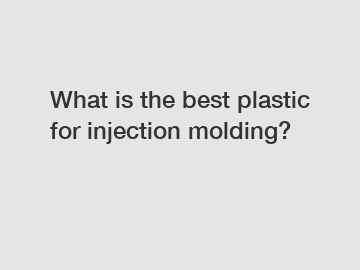What is the best plastic for injection molding?
Plastic injection molding is a highly efficient and versatile manufacturing process that has revolutionized the way products are made. This process involves melting plastic pellets and injecting them into a mold to create a specific shape. The type of plastic material used in injection molding plays a crucial role in determining the quality and properties of the final product. With a wide range of plastics available in the market, choosing the right one can be a daunting task. In this blog, we will delve into the best plastics for injection molding and discuss their unique properties and applications.
Polypropylene (PP) is one of the most commonly used plastics in injection molding due to its excellent strength, heat resistance, and chemical resistance. It is a versatile material that can be used in a variety of applications, including packaging, automotive parts, and household appliances. PP is known for its high impact strength and stiffness, making it ideal for products that require durability and structural integrity. Additionally, PP has a low melting point, which makes it easy to process during injection molding.
Acrylonitrile Butadiene Styrene (ABS) is another popular choice for injection molding due to its high impact strength, heat resistance, and surface finish. ABS is commonly used in the production of electronic housings, automotive parts, and consumer goods. It is a versatile material that can be easily molded into complex shapes and designs. ABS is also known for its excellent dimensional stability, making it an ideal choice for products that require tight tolerances and precise geometry.

Polyethylene (PE) is a lightweight and flexible plastic that is commonly used in injection molding for applications such as bottles, caps, and containers. PE is known for its high chemical resistance and excellent moisture barrier properties, making it suitable for products that require protection against external elements. Additionally, PE is cost-effective and easy to process, making it a preferred choice for mass production.
Polyethylene Terephthalate (PET) is a popular choice for injection molding due to its excellent clarity, strength, and barrier properties. PET is commonly used in the production of bottles, jars, and food packaging. It is a versatile material that can be easily recycled, making it an environmentally friendly option for manufacturers. PET is known for its high dimensional stability and resistance to creep, making it ideal for products that require long-term durability and performance.
Polycarbonate (PC) is a highly durable and transparent plastic that is commonly used in injection molding for applications such as automotive parts, medical devices, and electronic components. PC is known for its high impact strength, heat resistance, and flame retardant properties. It is a versatile material that can be easily molded into intricate shapes and designs. Additionally, PC is resistant to UV radiation and has excellent optical clarity, making it an ideal choice for products that require high visual appeal.
In conclusion, the best plastic for injection molding depends on the specific requirements of the product and the desired properties of the final product. Each type of plastic has its unique characteristics and applications, so it is essential to consider factors such as strength, heat resistance, chemical resistance, and cost when selecting the right material for injection molding. By understanding the properties of different plastics and their applications, manufacturers can choose the best material that meets their specific needs and delivers high-quality products.
For more information, please visit Upe Subgrade Board for Construction, Uhmw Plastic Sheet, What Is Pp Board.
199
0
0

Comments
All Comments (0)